Oriental Rugs and Rug Weaving in the Caucasus
The area of the Caucasus Mountains (bounded by the Black and Caspian Seas to the east and west, Russia to the north, and Turkey and Iran to the south) has produced very distinctive rug types since at least the end of the 18th century. Most "Caucasian" rugs are village pieces in scatter sizes with bold geometric designs in primary colors. Vegetable dyes were used exclusively until the 1860's when synthetic dyes began to appear. In structure, almost all of the rugs from this area use the asymmetric "Persian" knot, and most have wool pile on wool warp and weft. Warps are often strongly depressed, giving the back of the rug a characteristically corrugated appearance.
Recognized Caucasian types include: Daghestan, Genje, Karabagh, Kazak, Kuba (including ChiChi, Perepedil, and Seichur as sub-types), Lesghi, Moghan, Shirvan, and Talish. Exactly where in the area some of these types were woven is still open to dispute. Dozens of ethnic groups live in the area, and the evening news tells us that significant cultural and political changes are ongoing in the region.
By the late 1920's the Soviet government was finally in firm control of the Caucasus. The Soviets were in desperate need of foreign currency, and they tried to collectivize rug weaving in the same way they collectivized farming, and with the same dire results. The 1930's saw the production of "five-year plan" rugs which were inferior in every way to the weavings they replaced (these "five-year plan rugs" are now 60 year old "semi-antiques:" just another illustration that old does not necessarily mean good). WW II happened, and the weaving and selling of Oriental rugs was forgotten in the catastrophe of a world war happening in the weavers' backyard. The Soviets tried to resuscitate rug weaving in the 1950's, but results were no better than the rugs of the collectives. Even with the breakup of the old Soviet Union, the newly independent countries of the Caucasus are not sources of interesting rugs today.
Collectible Caucasian Rugs….
By the 1930's Caucasian types from the 19th century had become very collectible. Interest mounted until it reached almost manic proportions in Europe and the US in the 1960's and '70's. Truly old Caucasian rugs in any sort of reasonable condition are quite expensive in today's market, and are most available from specialist antique rug dealers or from the periodic rug auctions held by major auction houses.
We see few antiques like these….
 Antique DAGHESTAN Antique DAGHESTANPrayer rug design. Wool on wool, 72 knots/sq. in. 4' x 4'7" |
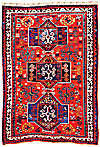 Antique KAZAK Antique KAZAKCommon "pole medallion" design. Wool on wool, 49 knots/sq. in. 5'11" x 8'7" |
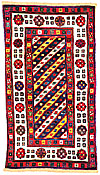 Antique GENDJE Antique GENDJETypical striped design. Wool on wool, 56 knots/sq. in. 3'1" x 5'5" |
New Rugs in Caucasian Designs….
Although no significanr rug production comes from the Caucasus today, several countries make rugs in Caucasian designs, some on wool foundation and with vegetable dyes. In the 1970's and 80's the best known of this production came from western Turkey. Unfortunately, as Turkey has Westernized, rug prices have risen to the point where new Turkish production is not competitive with rug types from some other areas. We still see some rugs from Turkey in Caucasian designs, but the "sweet spot" for Caucasian-style rugs lies these days with the Afghan production in Pakistan.
Some few rugs like these from Turkey still appear….
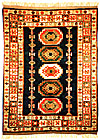 KAZAK KAZAK"Memlinc" gul design. Wool on wool, 63 knots; Turkey 5'3" x 8'9" |
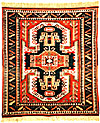 KAZAK KAZAK"Sewan" design. Wool on wool, 65 knots; Turkey 4'10" x 5'3" |
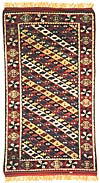 GENDJE GENDJE"Barber pole" stripe. Wool on wool, 77 knots; Turkey 2'8" x 4'7" |
Afghan weavers in northern Pakistan and rural Afghanistan weave excellent rugs very like old Caucasian pieces in size, design, and structure.
We often have rugs like these in stock….
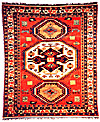 KAZAK KAZAK"Lori-Pambak" design. Wool on wool, 90 knots; Pakistan 5'4" x 6'3" |
 KUBA KUBAWool on wool, 81 knots; Pakistan 5'5" x 6'3" |
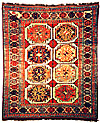 KAZAK KAZAK"Memlinc" gul design. Wool on wool, 72 knots; Pakistan 4'4" x 5'2" |
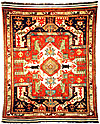 KAZAK KAZAKWool on wool, 72 knots; Pakistan 5'2" x 6'1" |
 SHIRVAN SHIRVANPerepedil design. Wool on wool, 90 knots: Pakistan 4'10" x 5'10" |
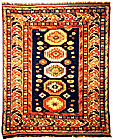 KAZAK KAZAK"Memlic" gul design. Wool on wool, 81 knots; Pakistan 5'1" x 6'1" |


